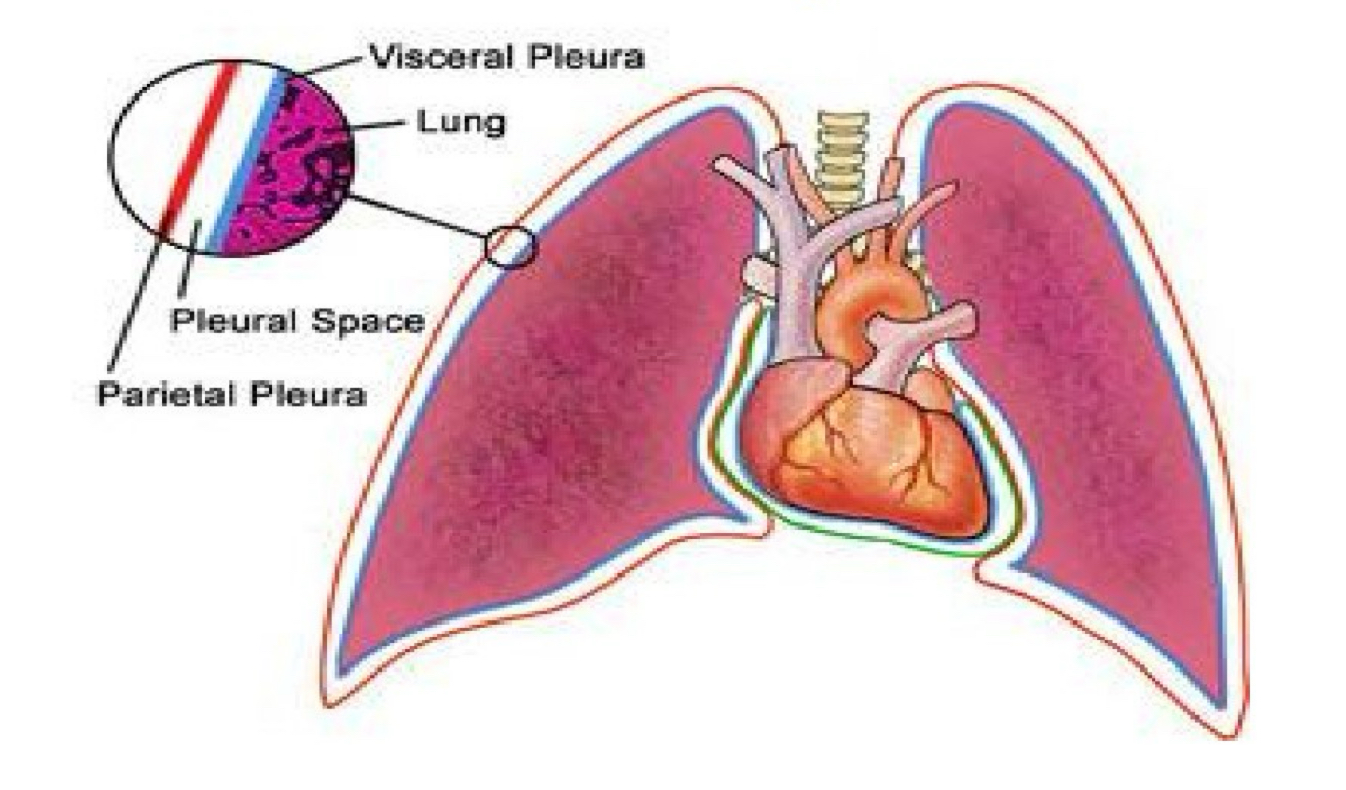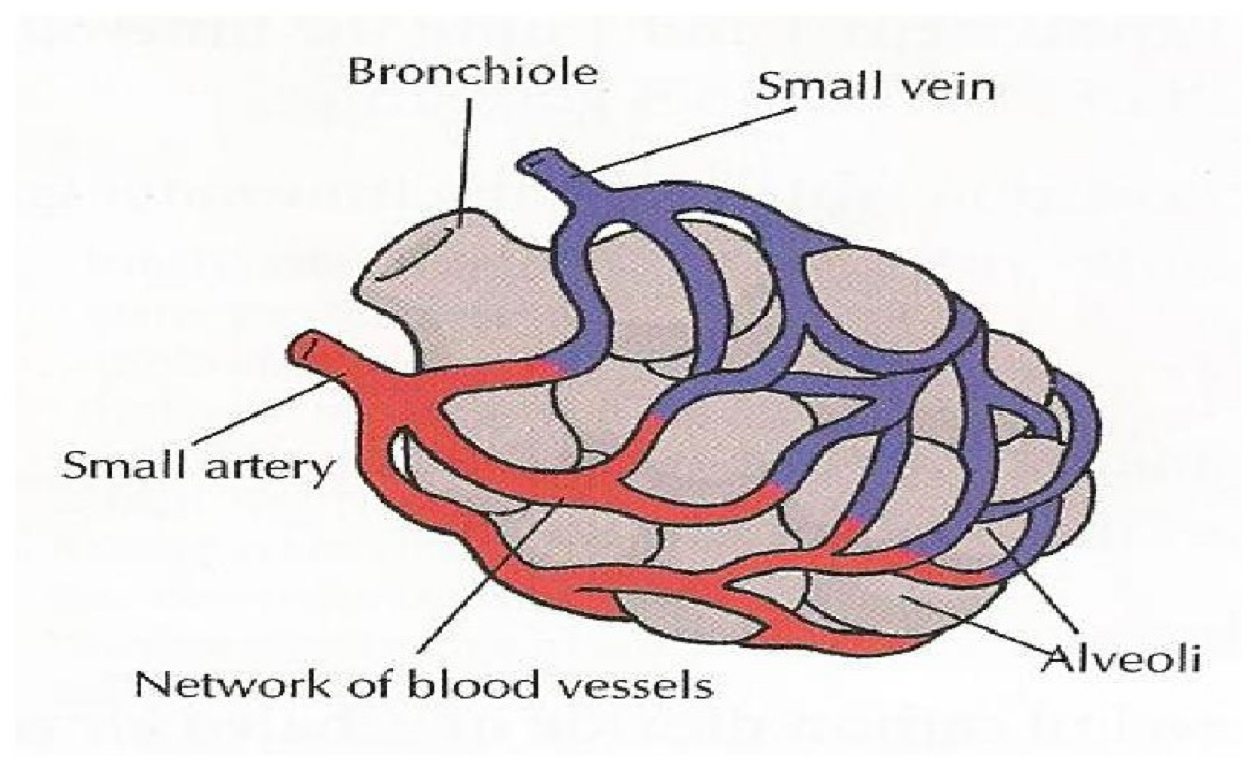Chapter 30: Human Breathing
We get our energy for metabolism by burning food in our cells (respiration)
We get fresh supplies of oxygen by breathing it in through our lungs.
The Respiratory System
Your lungs and heart are enclosed between the ribs and diaphragm in the thorax (thoracic cavity).
The diaphragm forms a musuclar floor to the thorax.
The ribs form a protective caage of twelve pairs of bones.
The ribs are surrounded by intercostal muscle and form the wall of the thorax.
These intercostal muscles which are attached between the ribs move the rib cage up or down.

Nose
Air can be inhaled through the buccal cavity or nose.
The openings of the nose are called nostrils. The nostrils are separated by the nasal septum, whcih is made of cartilage at the bottom of the nose and bone at the base.
We are meant to breah in through our nose for a number of reasons:
Hairs and mucuous in the nose trap and filter dirt and microorganisms.
Air entering the nasal passages is moistened.
The air is warmed as it passes through the nose.
This moistened warmed air diffuses more easily into the lungs.
Pharynx
Has both respiratory and digestive functions.
Is a 5cm long hollow tube.
The epiglottis closes off the trachea when swallowing food.
Directly below the epiglottis is the glottis which contains the larynx.
Trachea - Bronchi and Bronchioles
The trachea allows air to pass in and out of the lungs.
The bottom of the trache divides into two bronchi and then into smaller bronchioles.
The trachea, bronchi and bronchioles are made of muscle and elastic fibres.
The trache and bronchi are surrounded by rings of cartilage.
The bronchioles do not have rings of caartilage which cause them to narrow during asthma attacks.
All these air pipes are lined with mucuous secreting cells and microscopic hairs called cilia.
The Lungs
The lungs are large spongy structures which allow gas exchange.
The lungs are enclosed within a pair of pleural membranes.
The outer membrane is attached to the chest wall.
The inner membrane is attached to the lungs.

Alveoli
Each bronchus divides into about 1 million bronchioles which further divides into over 700 million alveoli and a surface area of 90m2
Each alveolus is only 1 cell thick, is moist and surrounded by rich supply of capillaries. This allows for quick gas exchange.

Gas Exchange
CO2 and H2O are in high concentration in blood plasma. They diffuse out of the blood capillaries and into the alveolus i.e. from area of high concentration to area of low concentration and vice versa.
Adaptations for Gas Exchange
Alveoli and capillaries have the following adaptations for quick gas exchange:
There are millions of alveoli
Alveoli are only 1 cell thick
Huge blood capillary network around each alveolus
Alveoli surrounded by thin layer of fluid
Capillaries are numerous
Capillaries are also only 1 cell thick
Transport of Gases
Oxygen combines with the red pigment haemoglobin found in RBCs. This combination results in oxyhaemoglobin. In this way 97% of oxygen is transported by RBCs - the other 3% dissolves into the plasma.
Carbon dioxide is carried by the blood, dissolved in the plasma. Water is transported in the plasma as well.
Inhaled and Exhaled Air
Gas | Inhaled Air | Exhaled Air |
% Nitrogen | 78 | 78 |
% Oxygen | 21 | 14 |
% Carbon Dioxide | 0.04 | 5.6 |
% Water Vapour | Low | High |
Mechanism of Breathing Inhalation
Brain controls breathing rate (medulla oblongata)
Intercostal muscles contract and move up and out
Diaphragm contracts and moves low - this increases volume of lungs (active process)
Air pressure in lungs decreases
External pressure is now higher which forces air into lungs

Mechanism of Breathing Exhalation
Intercostal muscles relax and rib cage moves down and inwards
Diaphragm relaxes and moves upwards decreasing volume of lungs (passive process)
Air pressure increases
Air is forced out of lungs

Exercise increases respiration rate especially in muscle cells. This increased respiration increases carbon dioxide levels in blood. The brain detects this increase of CO2 and so increases rate of breathing.
Exhalation which is usually passive becomes active.
Control of Breathing
Medulla oblongata controls breathing rate by monitoring levels of CO2 in the blood.
CO2 is slighlty acidic and causes the blood pH to decrease. This drop in pH is detected by the brain and sends signals to the diaphragm and intercostal muscles to contract resulting in intake of air.
In the same way this causes increase in breathing rate when exercising i.e. increase exercise leads to increased CO2 levels leading increased breathing rate.
Breathing Disorders
Asthma
Asthma results in the narrowing of the bronchioles which prevents air reaching alveoli.
Symptoms: Breathlessness and wheezing
Causes: Allergen e.g. pollen and house dust, tobacco smoke and air pollutants.
Prevention: Identification and avoidance of allergens. Preventative inhalers can also be used to prevent bronchioles from reacting to allergens.
Treatment: Inhaling a bronchodilator widens the bronchioles. Steroids reduce inflammation.
Bronchitis
When bronchi become inflamed and narrowed.
Symptoms: Persistent cough, breathlessness and production of a lot of mucuous.
Causes: Smoking and other air pollutants
Prevention: Never smoke
Treatment: Bronchodilator may be prescribed. In severe cases patients may have to inhale oxygen from an oxygen cylinder.